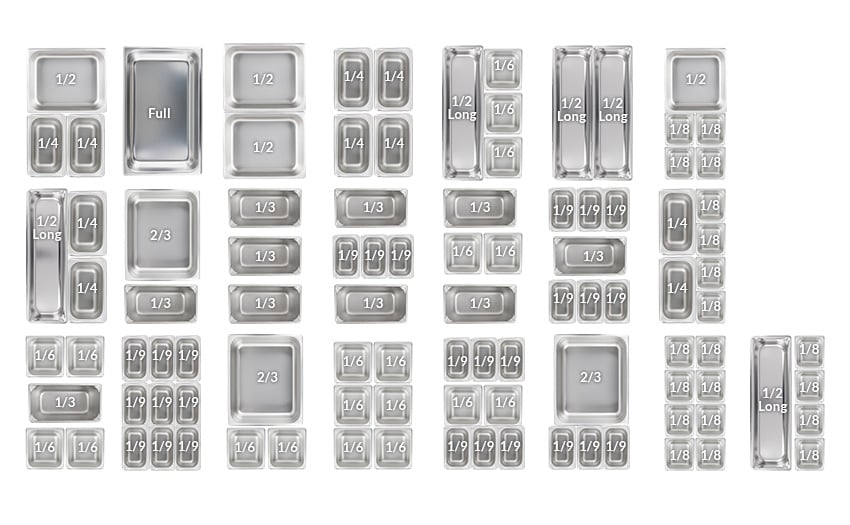
A Guide to Food Pans
Food pans are an essential tool in any commercial kitchen, providing a versatile and efficient way to store, transport, and serve food. Designed to withstand high temperatures and resist corrosion, food pans are suitable for use in ovens, steam tables, and cold storage. With their stackable design and compatible lids, food pans allow for easy organization and maximize space efficiency. Whether you need to store ingredients, prep food, or present dishes, food pans are a must-have for any foodservice establishment.
Shop All Food Storage Supplies
Full size food pans are the standard in the foodservice industry, measuring approximately 20 3/4" x 12 3/4". All other sizes of food pans are simply a variation of those dimensions. For example, a 1/2 size pan measures 12 3/4" x 10 3/8" and a 2/3 size pan measures 13 3/4" x 12 3/4". Continue reading for a more comprehensive breakdown of sizes and capacities.

Gastronorm Pan Sizing
Similar to the non-metric sizing that is largely used by the United States, gastronorm sizing was invented to provide an industry standard for pans and other kitchen equipment. The term, also known as gastronomical-normal, originated in Switzerland and is now widely used across most European countries. The main intention of the sizes was to promote flexibility in every kitchen and allow individual containers to be used with or transferred to a variety of appliances. Gastronorm sizes are comparable to American sizes and can generally be interchanged. Here's a list of the standard gastronorm (GN) steam table pan sizes in millimeters:
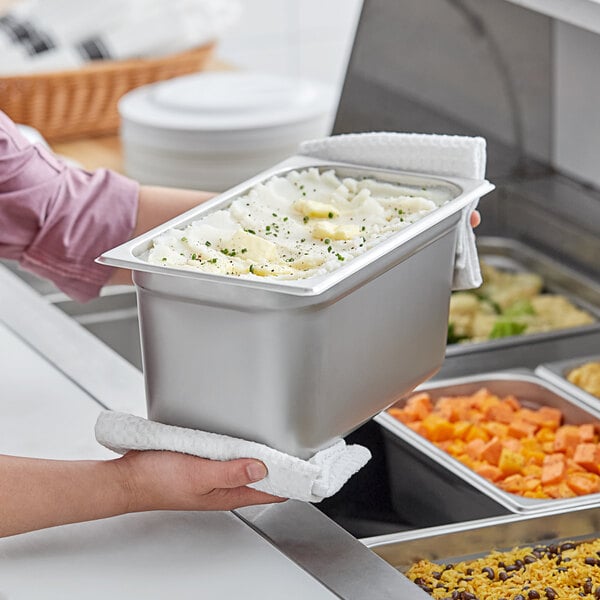
GN 2/1:
650 x 530 mmGN 1/1:
530 x 325 mmGN 2/4:
530 x 162 mmGN 2/3:
354 x 325 mmGN 1/2:
325 x 265 mmGN 1/3:
325 x 176 mmGN 1/4:
265 x 163 mmGN 1/6:
176 x 162 mmGN 1/9:
176 x 108 mm
Food Pan Depths and Capacities
In addition to the size of the food pan, depth is an important consideration. The number of servings in each steam table pan depends primarily on the depth of the pan. The most common hotel pan depths are 2", 4", 6", 8". They are also available in 1/2" or 1/4" increments.
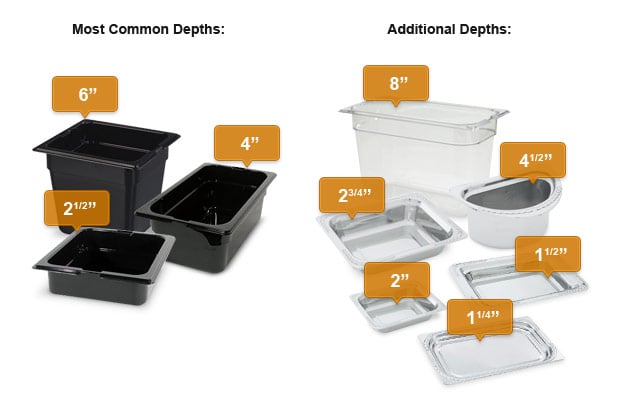
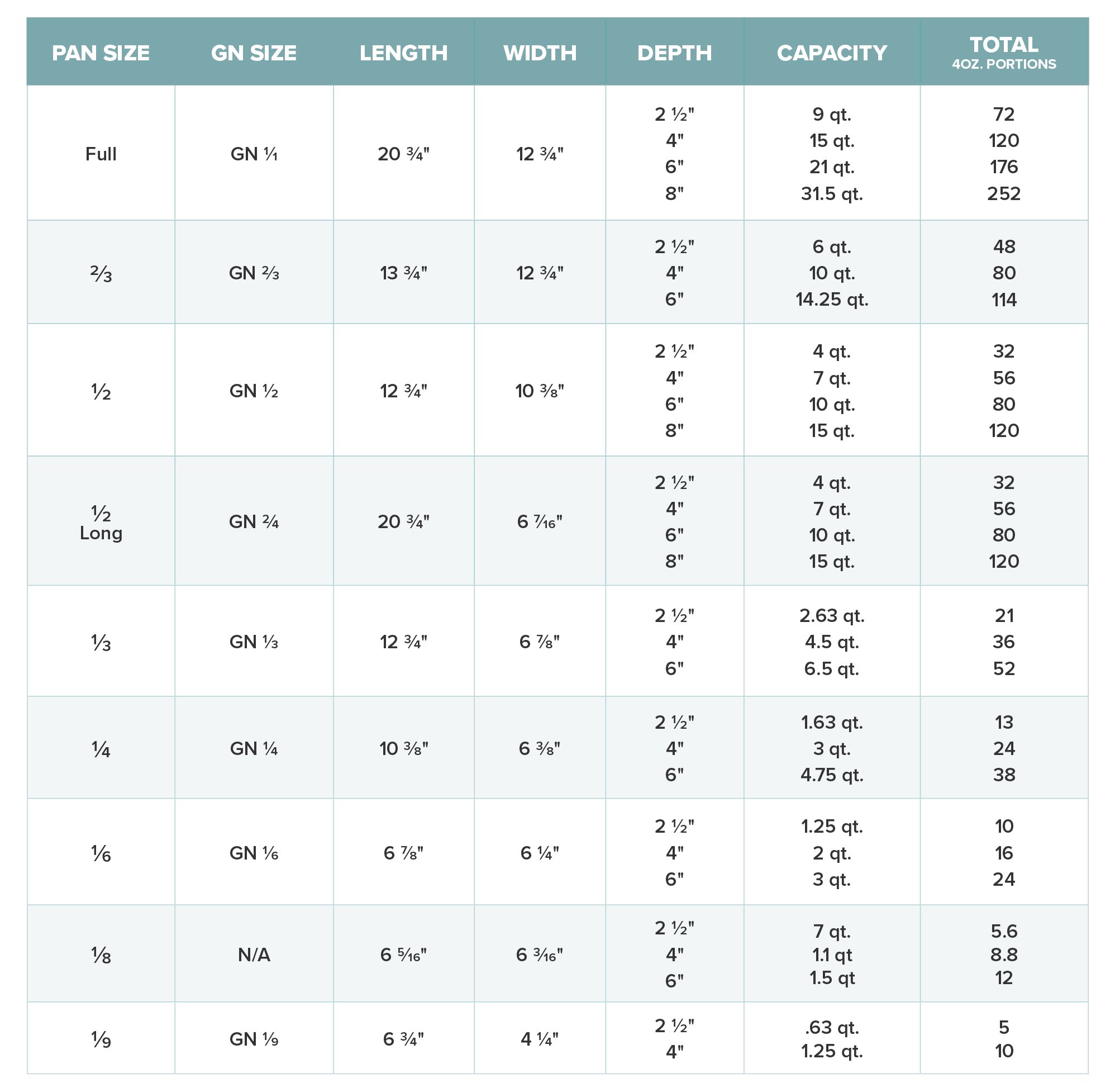
Pan sizes, depths, capacities, and total number of 4 oz. portions are approximate. Variations may occur between manufacturers. Please consider this when ordering.
When it comes to choosing the right food pans for your hotel kitchen, considering the type of material is crucial. Whether you operate a buffet or catering business, each type of pan material has its beneficial features to help you accomplish certain tasks in your commercial kitchen. We'll compare the most common food pan material to help you pick the best options for your business:
1. Stainless Steel Food Pans
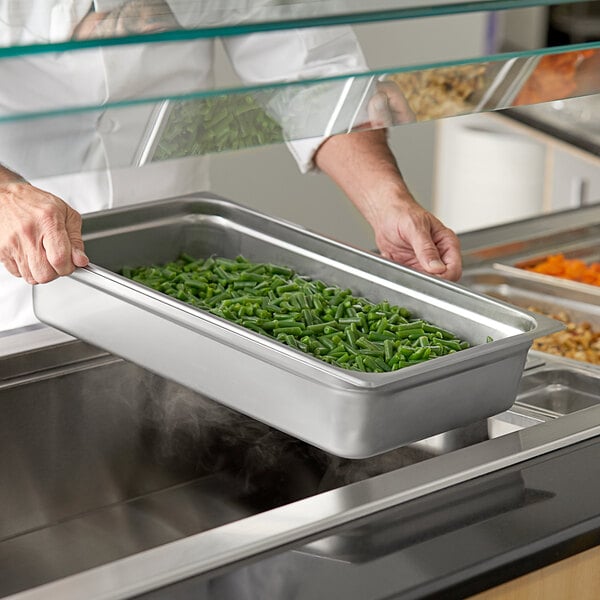
Stainless steel food pans offer the ability to go from freezer to oven to steam or refrigerated tables. This makes them ideal for operations ranging from fine dining restaurants to central kitchens employing cook-chill systems. Since stainless steel is a hard metal, it resists scratches and dents from metal utensils and is easy to clean.
Stainless Steel Gauges
The gauge indicates a pan's heft. While 22-gauge is a standard weight for hotel pans in the foodservice industry, lighter and heavier weights are available. The lower the gauge, the thicker the steel.
Lower Gauge/Thicker Steel:
Lower gauge food pans are a good choice for busier kitchens. They provide more even heating and are more resistant to denting and warping, but they can be more expensive and take longer to heat.Higher Gauge/Thinner Steel:
Operators with less volume may prefer a more economical high-gauge pan. They are cost-effective and lighter weight which means they will heat up quicker. Because of the thinness of the material, they can get damaged more easily and won't retain heat for as long as thicker gauges.
Types of Stainless Steel Food Pans
There are a variety of features a stainless steel food pan can come with in order to more precisely meet the unique needs of your business.

Perforated Food Pan:
A perforated food pan is designed with small holes throughout its surface, allowing for efficient draining of liquids. This feature is particularly useful when preparing foods that release excess moisture during cooking, such as steamed vegetables or poached fish. The perforations prevent the food from sitting in its juices, ensuring that it remains fresh and appetizing.Non-Stick Food Pan:
A non-stick food pan has a special coating that prevents food from sticking to its surface. This feature is ideal for cooking delicate items like omelets or fish fillets, as it allows for easy flipping and removal without any damage or breakage. It also simplifies the cleaning process, as food residue can be easily wiped away without the need for excessive scrubbing or soaking.Decorative Food Pan:
A decorative food pan adds an aesthetic touch to your food presentation. These pans are often embellished with intricate designs, patterns, or textures, elevating the visual appeal of your dishes. Whether you're serving at a buffet, catering event, or upscale restaurant, a decorative food pan can help create a memorable dining experience for your customers.Anti-Jam Food Pan:
An anti-jam food pan is designed with reinforced edges that prevent multiple pans from getting stuck together when stacked. This feature is particularly beneficial in busy commercial kitchens, where space is often limited. The anti-jam design allows for easy and hassle-free storage, as the pans can be easily separated without any struggle or damage.Easy Pour Corners Food Pan:
An easy pour food pan is crafted with specially designed corners that facilitate smooth and controlled pouring of liquids. This feature is particularly useful when serving sauces, gravies, or soups directly from the pan. The easy pour corners prevent messy spills and ensure precise portioning, making it easier for chefs and servers to plate dishes with precision.
2. Plastic Food Pans
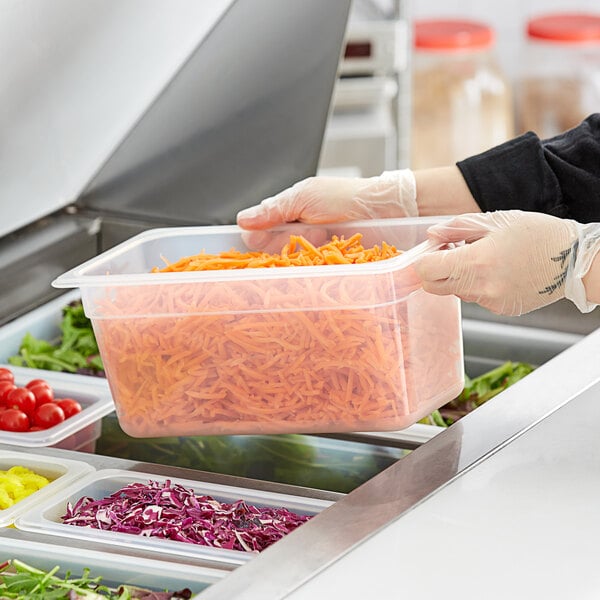
Plastic food pans come in regular, cold, and high-heat models to accommodate your needs. Unlike stainless steel pans, many plastic food pans are clear or come in several colors, allowing you to easily identify the contents of the pan or color code your storage area.
Types of Plastic Food Pans
Whether it's a polypropylene cold or food pan, each type offers unique features and benefits to enhance food storage, presentation, and overall efficiency in a commercial setting. These are some of the most common types of plastic hotel pans and their benefits:
Polypropylene Food Pan:
Offering a high chemical resistance, polypropylene food pans are an economical choice for your kitchen. They can withstand temperatures from -40 to 160 degrees Fahrenheit, making them an excellent option for hot-holding and cold food storage.Polycarbonate Food Pan:
Polycarbonate food pans are made to be shatter-proof and to resist food acids and oils. Although they are designed primarily for cold foods, polycarbonate food pans can withstand temperatures from -40 to 210 degrees Fahrenheit.High-Heat Food Pan:
High-heat food pans are made to withstand temperatures from -40 to 375 degrees Fahrenheit. They are usually amber in color to make them easy to identify in storage.Cold Food Pan:
Perfect for cold food storage, cold food pans can hold food safely below 41 degrees Fahrenheit for 6 to 8 hours. After freezing for at least 8 hours before use, some cold pans feature a color-changing blue exterior to indicate a safe cold holding temperature.
3. Display Food Pans
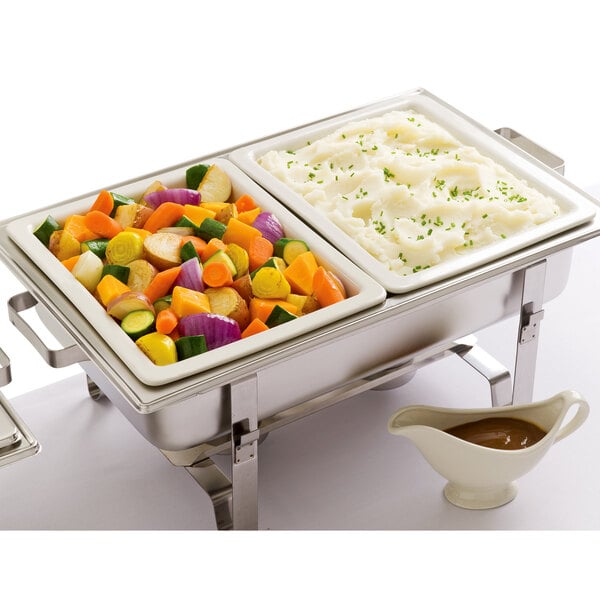
While stainless steel and plastic are most often used for food pans, other materials are excellent for aesthetic purposes.
Melamine Food Pan:
Melamine food pans offer an upscale, attractive alternative to stainless steel food pans and can be used in wet heat applications like chafers, just like stainless steel pans. They can stand heavy use and are a durable, practical, and inexpensive addition to any presentation.China Food Pan:
China food pans offer an upscale, sophisticated appearance, without sacrificing their superior heat and cold retention. These pans are specifically designed to distribute heat uniformly and help prevent scorching during use. They often feature bold glazes that bond to the china body to prevent chipping, crazing, or cracking.Cast Aluminum Food Pan:
Cast aluminum food pans bring you all the same benefits that other cast aluminum pans and products do. Cast aluminum is a great conductor of heat and cold and retains its temperature better than many other materials. It also features a stronger construction than melamine, while still providing a unique visual aesthetic to your buffet presentation. With an array of colors and sizes, you'll be able to find the right pans for your operation.
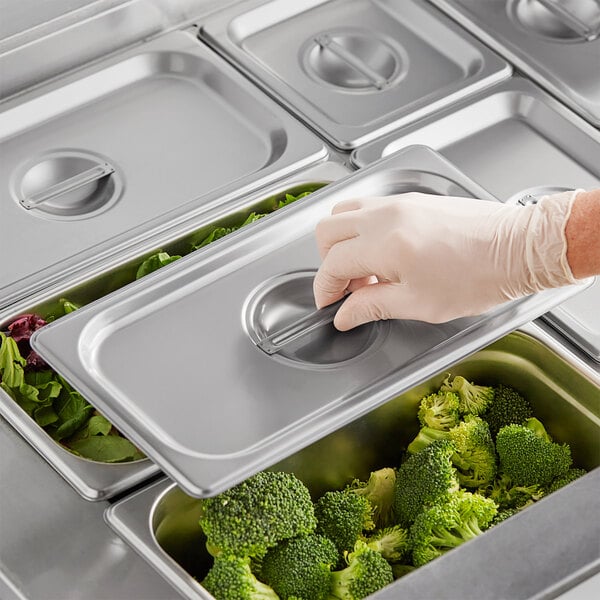
Food pan lids are essential for storing and transporting your food pans, while also keeping your food hot and safe from contaminants. We listed the most popular types of stainless steel food pan covers and plastic food pan lids below:
- Flip Top Lid: Flips upward for easy access to the pan's contents
- Seal Cover Lid: Flexible and closes tightly for safe, secure transport
- Slotted Lid: Features notches that allow spoons to remain inside the pan at all times
- Solid Lid: Covers the pan completely; comes with or without handles
- Hinged Lid: Hinged in the middle to serve food without entirely removing the cover
- Cook-Chill Lid: Features a snug fit that facilitates rapid, uniform chilling and rethermalization
- Dome Lid: Allows for food to be stacked high within the food pan
- Roll Top Lid: Allows for easy access to food without removing the cover
- Transport Lid: Offers a secure seal that prevents spillage during transport
- Steam Table Pan Band: Keeps lids, polyfilm, and aluminum foil secure
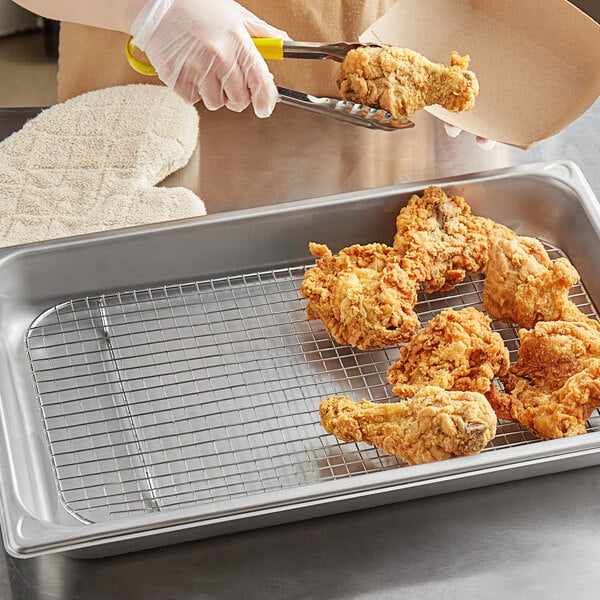
For a complete steam table setup, check out the following steam table pan accessories:
- Adapter Bars and Plates: Accommodate different configurations of pans in your steam table
- False Bottoms: Elevate your food from the bottom of the pan to prevent sogginess
- Disposable Pan Liners: Easily removed to cut down on cleanup time
- Steam Table Pan Templates: Cover unused food wells to maintain temperature
- Drain Grates: Elevate your food from the bottom of the pan to improve air circulation
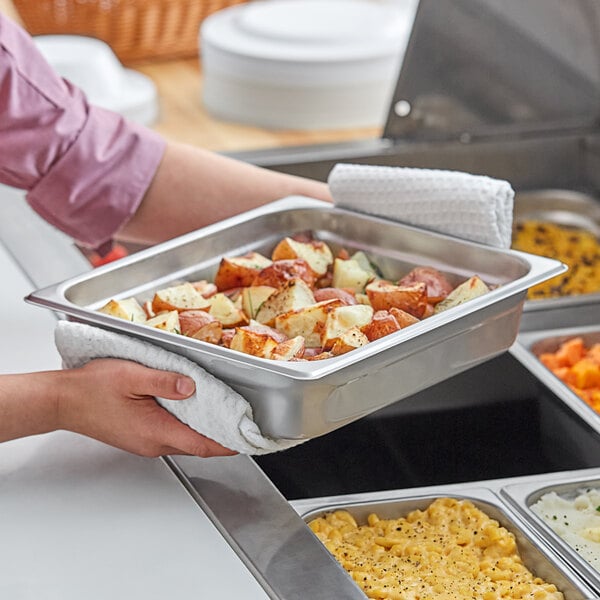
When choosing stainless steel food pans for your business, you'll want to go with a brand you can trust. Here are some of the top brands for your business:
- Choice: Choice delivers budget-conscious 24 gauge 18/8 stainless steel food pans in your commercial establishment that still offer excellent quality. These pans have anti-jam stacking lugs to ensure the pans don't stick together in storage.
- Vigor: Vigor offers durable 22 gauge, 300 series USA-made stainless steel food pans, designed to resist dents and dings in the busiest of kitchens. These pans are anti-jam and feature flattened edges to help prevent steam from escaping the pan well, making these pans energy and cost-efficient.
- Vollrath: Vollrath offers a variety of hotel pans ranging between 22 gauge and 20 gauge, 300 series USA-made stainless steel for extra strength. These food pans provide superior performance and a cost-saving design, making them perfect for high-volume foodservice establishments. They also offer the Jacob's Pride certification on most of their products which provides a lifetime warranty.
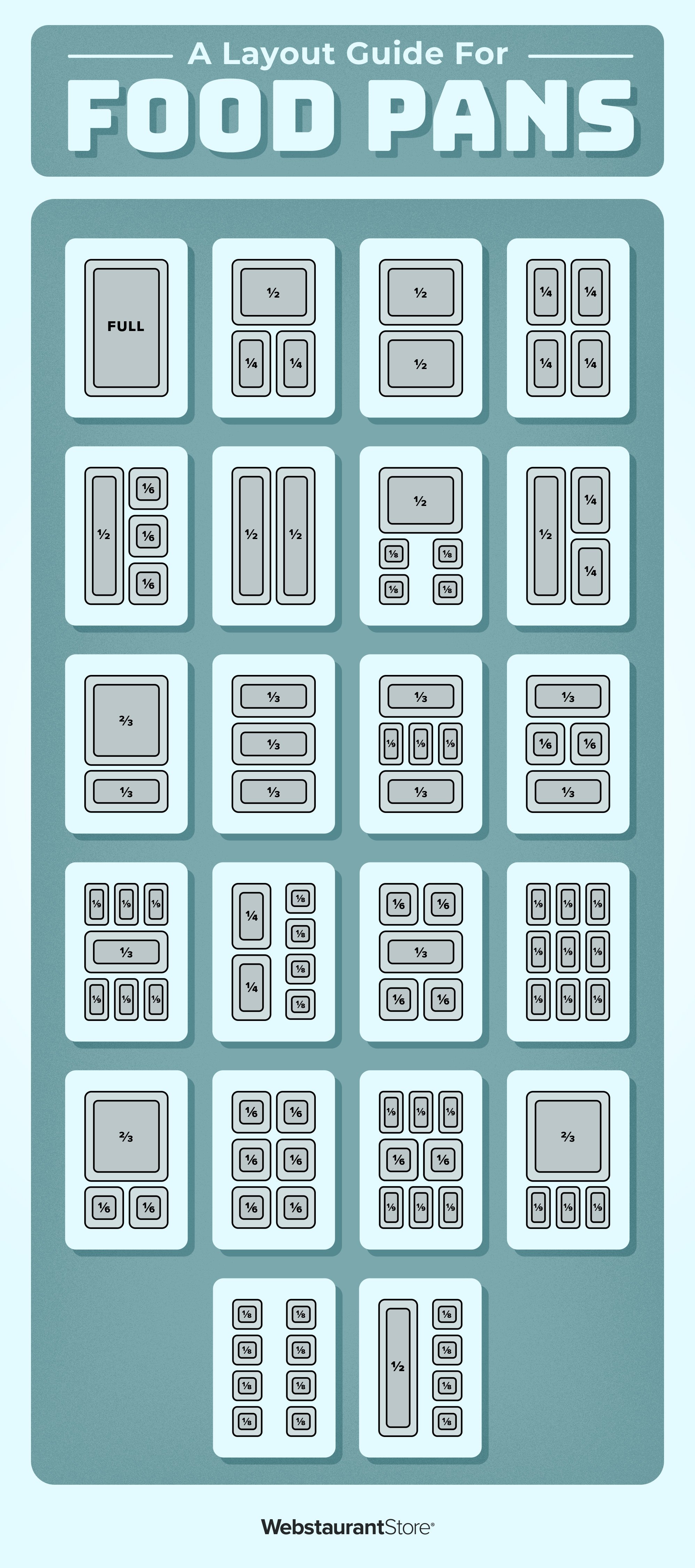
Related Resources
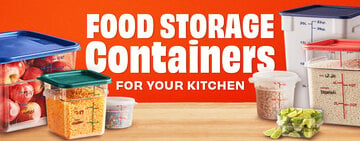
Types of Food Storage Containers
Food storage containers are essential to any commercial kitchen. There are different shapes, sizes, and materials, each with its own special function. Knowing which container to use for each of your food items is important for you to have a well-organized kitchen.
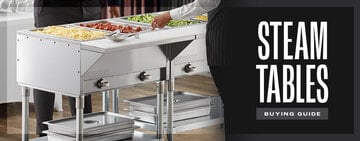
Steam Tables Buying Guide
Steam tables make it easy to serve a spread of hot food to a large crowd while maintaining food-safe temperatures. These tables hold hot food at ideal serving temperatures throughout meal service with either moist or dry heating, depending on whether or not water is used in the pan or well above the heat source. We'll review what a steam table is and the different types and styles so that you can select the best steam table for your operation. Shop All Commercial Steam Tables
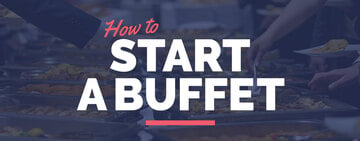
How to Start a Buffet
Buffets are a popular type of restaurant in the United States and can be found across the country in a variety of forms. The amount of food they need to produce presents many unique goals and challenges, differentiating them from other types of restaurants. As a result, there are some differences when opening a buffet as opposed to opening a traditional restaurant . Below, we'll break down everything you need to know about buffets, such as how they make money, the different types of buffets, and the steps you need to follow to open your own. What Is a Buffet? A buffet, also known as an "All You Can Eat" restaurant, is a type of restaurant where customers pay a fixed price to fill their plates with as much food as they'd like. Most buffets a
- Topics 1346
- Industrial 55
- Troubleshooting Guides 21
- Restaurant Management 128
- Bar Management 55
- Catering Tips 35
- Bakery Management 42
- Food Trucks & Concessions 49
- Advertising & Marketing 37
- Eco-Friendly Tips 11
- Facility Layout & Design 41
- Coffee Shop Tips 28
- Installation & Maintenance 51
- Janitorial & Pest Control 30
- Safety & Sanitation 88
- Startup Tips 104
- Menu Design 10
- Kitchen & Cooking Tips 81
- Hospitality Management 23
- Pizza & Sandwich Shop Tips 36
- Smallwares 37
- Food Prep 88
- Tabletop Items 17
- Disposables 22
- Calculators & Tools 6
- Consumables 52
- Warewashing & Laundry 18
- Cooking Equipment 90
- Food Storage & Refrigeration 51
- Beverage Equipment 34
- Office Supplies 6
- Resource Type
- In-Depth Articles272
- Buying Guides296
- How-Tos93
- Product Reviews77
